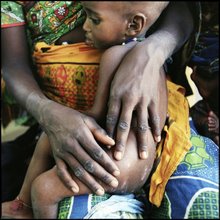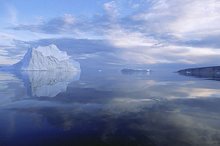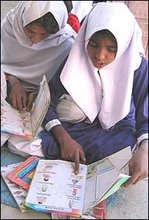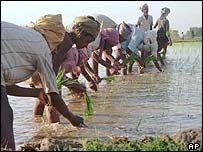PREAMBLE: We selected dengue fever for this issue because both principals of PacificSci developed this disease while visiting the island of Trinidad in the West Indies in December 2008. Characterized by headache, muscle and joint pains, spiking fever; and (in one of us) a petechial (hemorraghic) rash, the other of us was admitted to hospital for dehydration and a major fall in platelet count (20,000; normal = 150,000-400,000). We tested positive to an IgM laboratory test, indicative of acute infection. We returned to Canada in mid-January and are convalescing.
Given the incubation range for dengue fever, typically 4-7 days, it is likely that we were exposed within 24 hours of entry into Trinidad, either on arrival at Piarco airport, or subsequently at a residential area on the north-west boundary of Port of Spain. Although the Ministry of Health maintains a mosquito control programme at the airport, an active epidemic of dengue fever had been reported by the media for several weeks in adjacent communities to the east of Port of Spain; locally employed baggage handlers could have served as a reservoir. Initially downplayed by the Ministry of Health (according to media reports), the Pan American Health Organization records 2,366 cases including deaths by the 37th week of in 2008 in Trinidad, which translates to well over 3000 cases by year end.
Source: http://www.paho.org/English/AD/DPC/CD/dengue-cases-2008.htm
Since the late 1970s dengue fever reemerged as an expanding public health problem in the Caribbean basin. Because the situation now involves co-circulation of three serotypes, the threat to personal and public health has actually heightened because a primary infection does not immunize against subsequent infection from another strain; to the contrary, it sets up a complex immune response that may result in serious disease e.g, dengue hemorrhage fever and dengue shock syndrome. This threat is compounded by climate change which is having the effect of both extending the range of the mosquito vector and also the length of the mosquito breeding season.
[See: accompanying articles below for more details].
Although there has been plenty of warning about this increasing threat, diminished priorities for public health e.g., education and mosquito abatement, plus deteriorating infrastructures e.g, drains and ditches which trap fresh water (ideal for mosquito breeding), have exacerbated the impact of this condition in many countries. Concerns for the potential impact on tourism have contributed to insufficient recognition by the political establishment, an inappropriate response because ultimately this disease will become more firmly established, and affected countries will become globally recognized as endemic for the disease. The major risk is of course for the people of the affected countries, especially those who live in heavily mosquito afflicted areas. The adequacy of the health care system in many instances may not be sufficient to cope with epidemic surges; clearly therefore the appropriate response is to refocus on prevention.
PRIOR WARNINGS OF GEOGRAPHIC EXPANSION AND INCREASED SEVERITY - HAVE THEY GONE UNHEEDED?
Over a decade ago [1], mathematical models simulating climate change projected that rising global temperatures will increase the range of mosquitoes that transmits the dengue fever virus, even then considered the most serious viral infection transmitted in man by insects, whether measured by number of infections or the number of deaths.
Researchers used three different models to show that dengue's epidemic potential increases with a relatively small temperature rise. The higher a virus's epidemic potential, the fewer mosquitoes are necessary to maintain or spread dengue in a vulnerable population. Most predicted areas of encroachment were temperate regions that border on endemic zones, places where humans and the primary carrier, the mosquito Aedes aegypti, often co-exist, but where lower temperatures until then limited transmission.
Global warming would not only increase the range of the mosquito but would also reduce the size of Ae. aegypti's larva and, ultimately, adult size. Since smaller adults must feed more frequently to develop their eggs, warmer temperatures boost the incidence of double feeding and increase the likelihood of transmission. In addition, the time the virus must spend incubating inside the mosquito is shortened at higher temperatures. Shortening the incubation period can mean a potential higher transmission rate of disease.
NOTE: The foregoing study was co-funded by the U.S. Environmental Protection Agency, the National Institute of Public Health and Environment (RIVM) (the Netherlands), and the Center for Medical, Agricultural, and Veterinary Entomology of the U.S. Department of Agriculture.
According to a recent report [2], published by the US Centers for Disease Control and Prevention, dengue is expanding in tropical and subtropical regions and is now the most frequent arboviral disease globally, with an estimated annual 100 million cases of dengue fever, 250,000 cases of dengue hemorrhagic fever, and 25,000 deaths (a 1% fatality:case ratio). Dengue has been reported in >100 countries, and 2.5 billion people live in areas where it is endemic.
Increasingly reported in travelers, dengue is a major international public health concern because of the expanding geographic distribution of the virus and competent mosquito vectors, increased frequency of epidemics, co-circulation of multiple virus serotypes, and emergence of dengue hemorrhagic fever in new areas.
References:
1. Science Daily Mar 10, 1998 http://www.sciencedaily.com/releases/1998/03/980310081157.htm
2. Wilder-Smith et al in the January 2009 issue of Emerging Infectious Diseases http://www.cdc.gov/EID/content/15/1/8.htm
MORE GLOBAL NEWS ON DENGUE FEVER
The situation as experienced described in our preamble is by no means limited to the Caribbean basin. A report published in Time magazine in 2007 reveals – among other things - that denial and inertia regarding dengue fever is widespread. Political leadership clearly has been insufficient in many countries to respond adequately to this threat. The following is extracted from a TIME Magazine report in 2007 (citation below):
“Across Southeast Asia, doctors and public-health officials are grappling with alarmingly high dengue-infection rates. Cambodia and Vietnam reported double the cases this year (2007) compared with (the prior year), and more than 400 deaths; Thailand and Burma each recorded roughly a third more cases in 2007. The World Health Organization (WHO) says this is the fourth consecutive year of unusually high rates in the region — and doctors are worried that global warming may be partially to blame.
That's because the mosquito that infects most people with dengue, the striped Aedes aegypti, does better in warm, wet weather. Regions experiencing rising temperatures and longer rainy seasons are seeing large outbreaks year after year, and what has previously been thought of as a tropical disease is popping up in more temperate regions. Nepal and Bhutan saw their first cases in recent years, as did isolated spots such as Easter Island. Today, an estimated 2.5 billion people live in areas where dengue is endemic. The WHO expects millions more will be added in coming years. ‘Dengue is an evolving situation,’ says Dr. Jai Narain, director of communicable diseases for the WHO in Southeast Asia. ‘A lot of people say climate change will impact [the disease] somewhere down the line. But it already is.’
Weather isn't doing the job alone. As more and more people migrate to cities, they create additional opportunities for the mosquito to spread the virus. The problem is particularly acute in developing countries, where inadequate utilities mean residents must store water in jars and tanks — prime breeding grounds for the Aedes aegypti. Increasing air travel is also a factor as infected fliers spread the disease quickly worldwide. ‘It's simplistic to suggest that the increasing outbreak is solely caused by climate change,’ says Simon Hales, a senior research fellow at New Zealand's University of Otago. ‘But those who would suggest that it has nothing to do with it are equally misguided.’ Hales estimates that if global warming advances as predicted by the U.N., more than half the world could be dengue country before the end of this century.
Lacking vaccines or effective treatments [Ed Note: neither option exist for dengue, which has not received adequate attention to this needed research and development], public-health officials are battling the disease with old-school tactics: pest control and education. But fumigation campaigns are too expensive for many Asian governments to carry out effectively; it's also difficult to regularly send out health officials to remind communities to keep their homes dry and water supplies clean. Even wealthy Singapore, a model of dengue control, was floored by an outbreak in 2005. Reported cases went down the following year, but are back up again slightly in 2007. ‘That's a kind of warning to us," says Hales. "As the temperature continues to increase, it gets progressively more difficult to prevent the disease from spreading — even with the best technology.’
Health-care professionals are trying to raise global awareness of the threat. In Cambodia, for example, more funding goes to controlling avian flu, a disease that affects far fewer people but has a higher fear factor worldwide. Health organizations such as the U.S.-based Centers for Disease Control and Prevention are stressing the link between climate change and disease, hoping to get more money to fight mosquito-borne illnesses.
‘This is a critical moment,’ says Dr. Maria Neira, director of the WHO's program on public health and the environment. ‘If the public pressure is maintained, the politicians will act accordingly. Waiting for dengue fever to burn itself out may be the only option for individuals who catch the disease, but that's a lousy prescription for the planet.’ “
Source: Krista Mahr Thursday, Dec. 06, 2007 TIME MAGAZINE http://www.time.com/time/magazine/article/0,9171,1691616,00.html
FROM a Great Canadian and World Statesman
"A great gulf... has... opened between man's material advance and his social and moral progress, a gulf in which he may one day be lost if it is not closed or narrowed..."
Lester B Pearson
http://nobelprize.org/nobel_prizes/peace/laureates/1957/pearson-lecture.html
Saturday 14 February 2009
Subscribe to:
Posts (Atom)
INSPIRATIONAL WELCOME ............................... from T.S.Eliot's "Little Gidding"
If you came this way From the place you would come from... It would be the same at the end of the journey...
If you came, not knowing what you came for, It would be the same... And what you thought you came for Is only a shell, a husk of meaning... From which the purpose breaks only when it is fulfilled If at all.




















